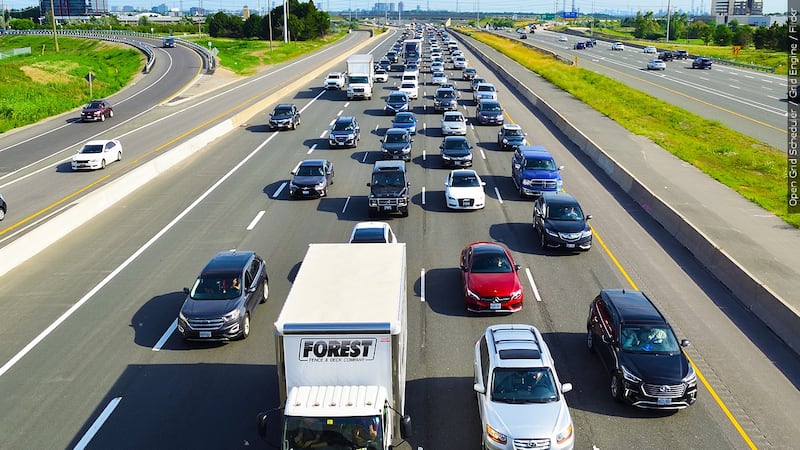Concerns tariffs could impact construction in Kansas City
KANSAS CITY, Mo. (KCTV) - The Kansas City metropolitan area has continued to grow, with new developments, projects, and construction announced over the years.
“It’s been really busy,” said Ralph Oropeza, the business manager at the Greater Kansas City Building & Construction Trades Council. “We have a record number of projects, and we have a record number of people coming from all over the country to the Kansas City metro area to do these projects. We are extremely excited about the amount of projects we have going on.”
With President Donald Trump’s 25% tariffs on imports from Canada and Mexico starting Tuesday, there are concerns that could put a pause on the progress. Oropeza says the tariffs could bring uncertainty, and may slow down or halt projects in the area.
“While larger scale firms that are creating these huge data centers may be able to absorb some of that loss, our smaller scale projects will be directly impacted because there not as affluent with money that is readily available for them to recoup any costs,” said Oropeza. “The smaller projects, which make up way more projects: housing, small commercial, small industrial, if those slow down, where are those people going to work? It directly impacts the economy, everyone around.”
Tariffs are taxes charged on goods imported from other countries. The companies that bring the foreign goods into the country pay the tariff, or tax, to the government. Companies could choose to on some, or all, of the cost of tariffs to customers. Oropeza says the tariffs could impact their workforce and apprenticeships while also having a ripple effect on the local economy.
“We go out, we shop, eat at local restaurants, we save a little bit, buy our homes, but we directly impact our local economy,” said Oropeza. “If work goes away or slows down, the ripple effect isn’t just going to be the construction worker. It’s going to be the shop owners, it’s going to be the restaurant owners, it’s going to be movie theaters where we would normally go but now we can’t because we can’t afford it because we don’t have jobs to go to.”
The Trump istration has indicated there could be short-term pains for long-term gains, where manufacturing jobs will begin to flow into the U.S. when businesses don’t want to pay the extra tax.
“For me, it’s buy America first,” said Oropeza. “I have always been ive of American products. Being a union member, we want to our American workforce, right? But we have grown into a global economy. The supply chain isn’t just domestic, it’s also worldwide now. When you start disrupting that supply chain, that’s the bad part. Yes, we are going to protect some of our domestic suppliers, but there are not enough domestic suppliers to create that food chain, for lack of better , that feeds these projects.
“You have to rely on our suppliers that are abroad to help with us copper for plumbing or electrical, aluminum, wood, wood from Canada, things like that to help us build homes, buildings. While we a lot of our domestic partners, it’s the world partners that are definitely going to get disrupted and it’s going to have ripple effect on the construction here in the United States.”
When the 25% tariffs on Canada and Mexico, plus 20% tariffs on goods imported from China, they could affect a variety of things.
“Unfortunately for us, we feel it directly,” said Stacia Williams, a wealth advisor and co-founder of Williams Financial Group. “When you go to purchase things, you will notice if things become more costly. I have some friends in the cosmetology industry and retail space, where the goods they have imported to sell to consumers, they are now having to increase the price. Which in turn means the consumer will see those prices go up.”
Williams says now is a good time to take a look at your budget.
“The best way to prepare is to always budget,” said Williams. “When we talk about looking at the budget, look at what you’re spending now versus what you could be spending later. There’s a rule of the 50-30-20. Spending your income on 50% of your needs, 30% on your wants, and 20% goes towards savings. I always encourage saving, so maybe it’s time now to cut back on the wants and start placing more of those monies towards the savings bucket to ensure that you are covered.”
She also has advice for those looking to retire within the next couple of years.
“Have a written, wholistic income plan,” said Williams. “Understand where your monies are going to come from in retirement. Understand how those monies are going to grow in retirement. Understand if you need a different strategy. Sitting down and working with a professional to put together a written income plan will allow for you to be able to pivot in the case that something gets more expensive, you’ll know where you can pull from and adjust your portfolio to be able to stay comfortable.”
If you have any questions, Williams says it’s best to consult with a professional.
Copyright 2025 KCTV. All rights reserved.















